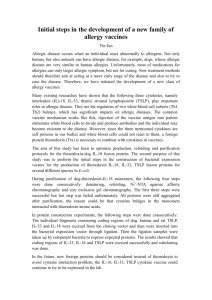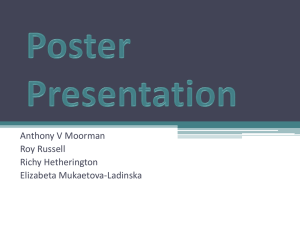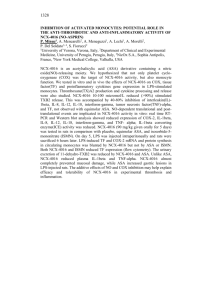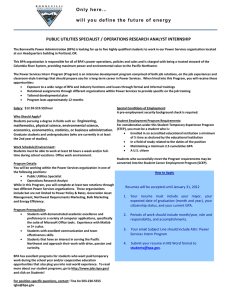Anthony V Moorman Roy Russell Richy Hetherington Elizabeta Mukaetova-Ladinska
advertisement
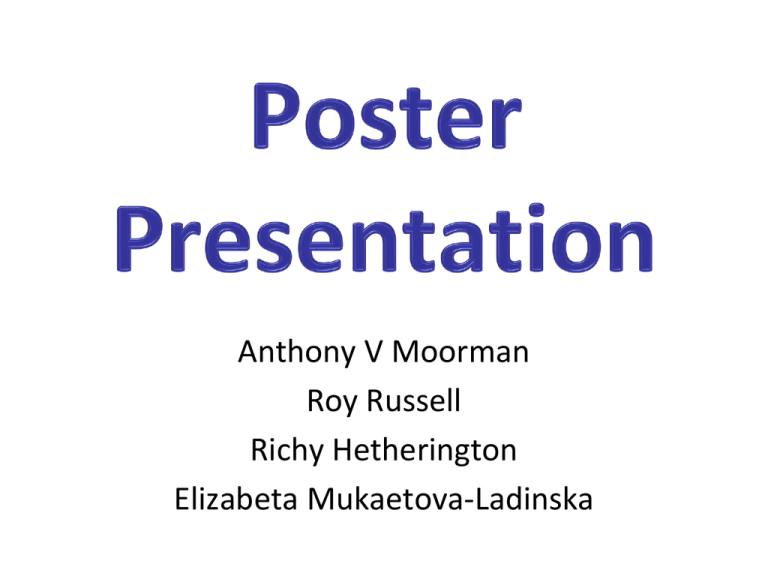
Anthony V Moorman Roy Russell Richy Hetherington Elizabeta Mukaetova-Ladinska Overview of Session • Talk – Review communication modes in science – Advantages and disadvantages of posters – Features of a good poster – Tips and hints • Interactive section – Review posters in groups – Group discussion Modes of Communication in Science • Written (i.e. paper / article) – good for detail; time to digest; possible to include complex material Clear beginning, middle and end; Reader can combine with other sources of information to clarify anything that is not clear • Oral/Spoken/Verbal – good for explaining; can get feedback from listener(s) Limited attention span but possible to repeat or explain technical jargon appropriate to audience • Visual/Poster – initial impact; memorable image No personal contact; limited viewing time; competing for attention When are posters used? • Meetings/Conferences – General, Specialist, Clinical – Large, Small – National, International • Open days – Entertaining fundraisers – Attracting staff, students – Informing general public • Site Visits / Visits from Funding Bodies • Corridor decoration Pros and Cons of the Spoken Presentation PROS Large audience High visibility of speaker Opportunity to stress specific points Easier to prepare Last-minute changes possible Slides reusable CONS Nerve-wracking Not all audience interested Often few questions/little discussion Pros and Cons of the Poster Presentation PROS Good for certain kinds of data Attracts interested viewers Opportunity for discussion Good if you are a nervous speaker Good if English is not your first language CONS Time consuming to make Cost May miss viewing parallel posters Poster Sessions What is in it for the viewer? • Can be selective • Opportunity to meet presenter - ask detailed questions - ask simple questions • • • • Can eavesdrop / join in discussions Time to think about content Can take notes, get methods, references Chance to mention your own interests What is a poster? A large, usually printed placard, bill, or announcement, often illustrated, that is posted to advertise or publicize something A good poster will rapidly allow the reader to answer the questions: What is this about? What are the authors trying to do? What is the take-home message? Questions the viewer asks: • What is this about? • What are they doing? • What is the bottom line ? Title, picture Aims Conclusion • How did they do it? • Who are these guys? • How can I find out more? Methods, Results Names, Presenter Contact address, references What makes a good poster? • Grab attention • Give information • Memorable message Know your audience • Expert, semi-expert, patients, fund-raisers, general public • THINK about content, text and terminology – Avoid acronyms – even ones that seems obvious to you – No jargon / Do not assume knowledge – Always ask yourself - do they need to know this piece of information in order to understand my message? Poster Style • Visual impact • Title • Layout • Readability Poster Layout • Landscape better than portrait 3 columns – reduces line length Poster Content • Authors • Aims • Methods • Results • Conclusions • ? References Title • Possibly the most important aspect of the poster. • First thing viewers will read. • Short but needs to capture the essence of the poser • Choose your wording carefully and remember that the more words you have, the more space they will take up. An Investigation Into The Contributory Factors That Improve The Visual Presentation Of Scientific Results In A Conference Scenario. AN INVESTIGATION INTO THE CONTRIBUTORY FACTORS THAT IMPROVE THE VISUAL PRESENTATION OF SCIENTIFIC RESULTS IN A CONFERENCE SCENARIO. An Investigation Into The Contributory Factors That Improve The Visual Presentation Of Scientific Results In A Conference Scenario. An investigation into the contributory factors that improve the visual presentation of scientific results in a conference scenario An investigation into the contributory factors that improve the visual presentation of scientific results in a conference scenario Remove redundant words Factors that improve visual presentation of scientific results (note how you can now make the text bigger) The case for lower-case Factors that improve visual presentation FACTORS THAT IMPROVE VISUAL PRESENTATION Size matters 12 Readability 10 8 6 4 2 50 44 38 32 26 20 14 8 2 0 Font size Relationship between size of font used in a figure and the ease with which it can be read at a distance of 1 m assessed using a ten-point scale (readability ) First Impressions Count! ‘…an unattractive poster with high scientific merit risked being overlooked on first impression’ Smith PEM et al (2004) J R Soc Med 97:340 Corporate Visual Identity Newcastle University Policy and Regulations http://www.ncl.ac.uk/cvi-support/ Do NOT forgot your sponsor! Some examples IL-18 and Immune Responses to Periodontal Pathogens Leah Jamieson (supervisors Neil Foster and John Taylor) 2020 Oral Microbiology and Host Responses Group, School of Dental Sciences, University of Newcastle email: L.M.Jamieson@ncl.ac.uk Aims Introduction The latest UK Dental Health Survey revealed that 40-45% of adults have moderate destructive periodontal disease, with 5-10% of cases being severe. Periodontal disease is a result of excessive immune responses to dental plaque bacteria which destroy the supporting tissues of the teeth, leading to loss of dental function. A novel ELISA was developed to detect IL-18 BPa. Anti-IL-18 BPa was added to the supernatants of P. gingivalis stimulated cells to investigate the effect on IL-18 concentration. The addition of anti-IL-18 BPa significantly (P <0.05) increased the concentration of IL-18 assayed by the ELISA (Figure 4). 3000 Results IL-18 concentration (pg/ml) • To establish whether human THP-1 monocytes produce IL18 when stimulated with Porphyromonas gingivalis LPS To examine the relationship between pro-inflammatory IL-18 and anti-inflammatory IL-18 BPa Both P. gingivalis and E. coli LPS induced IL-18 secretion in THP-1 monocytes as demonstrated by ELISA and Western blotting (Figure 1 & 2) as well as IL-18BPa (Figure 3). 2500 * * 1.5 15 2000 1500 1000 500 0 0 1800 IL-18 concentration (pg/ml) • * 1600 1400 0.15 Anti-IL-18 BPa antibody conc (μg/m l) * 1200 * * 1000 800 * Figure 4: Addition of anti-IL-18 BPa to P. gingivalis LPS stimulated supernatants (6h) significantly increases IL-18 detection by ELISA (N= 3) (* = P< 0.05) 6h * 24h 600 400 200 Discussion 0 Pg Ec PMA Unstimulated control Treatment Clinical signs of destructive periodontal disease Cytokines play a central role in inflammatory processes that influence the progression of periodontal disease and its clinical outcome. Interleukins (IL) are a group of cytokines produced primarily by leukocytes. IL-18 has pro-inflammatory properties. It induces production of interferon (IFN)-γ which has a major role in the activation of cells of the immune system. IL-18 binding protein (BPa) strictly controls IL-18 activity by blocking binding to the IL-18 receptor on target cells and IL-18 BPa expression is stimulated by IFN-γ. This is an important regulatory circuit as overproduction of IFN-γ causes tissue pathology. However, there is no information on IL-18 in the pathogenesis of this disease. Figure 1: ELISA analysis to quantitate IL-18 secreted by THP-1 cells exposed to LPS from P. gingivalis and E. coli. Cultures with PMA and PBS served as positive and negative controls respectively (N= 6) (* = P <0.05) P. gingivalis E. coli - ve → Figure 2: Western blot of IL-18 protein in supernatants from THP1 cells exposed to LPS from P. gingivalis and E. coli (6h) 0.7 * * 0.6 * * IL-18BPa (620nm) Cells from the pro-monocyte cell line THP-1 were treated with Vitamin D3 (0.1 μM) to induce differentiation into monocytes. Differentiation was confirmed by the ability of the cells to adhere to the plastic plate. THP-1 monocytes were cultured with lipopolysaccharide (LPS) from the periodontal bacterium P. gingivalis and the enterobacterium E. coli for 6 and 24 hours. The concentration of protein in each sample was determined by a protein assay and IL-18 concentrations were measured using an ELISA assay kit and detected via a Western Blot. Conclusions * 0.5 Methods The results indicate that significant concentrations of IL-18 and IL18BPa are produced by human THP-1 cells within 6 hours of initial exposure to P. gingivalis LPS. Antibodies to IL-18BPa increased the amount of free IL-18 in LPS-stimulated THP-1 cultures indicating that IL-18BPa normally binds IL-18 secreted from THP-1 monocytes. The balance between IL-18 and IL-18 BPa may be important in regulating IL-18 activity and may play a role in the host response to plaque bacteria, and possibly progression and severity of periodontal disease. This work also indicates that antibodies or binding proteins could be used to modify immune responses involving cytokines and therefore be used therapeutically in the treatment of periodontal disease. 0.4 6Hr 24 Hr 0.3 • The balance between IL-18 and IL-18 BPa may be important in immune responses to periodontal bacteria 0.2 • 0.1 0 PBS Pg Ec PMA Figure 3: ELISA analysis of IL-18 BPa secreted by THP-1 cells exposed to LPS from P. gingivalis or E. coli. Cultures with PMA and PBS served as positive and negative controls respectively (N =3) (*= P< 0.05) This system may represent a novel immunoregulatory circuit in periodontal disease and a potential therapuetic target Acknowledgements This project was supported by a Wellcome Trust Vacation Scholarship IL-18 and Immune Responses to Periodontal Pathogens Leah Jamieson (supervisors Neil Foster and John Taylor) 2020 Oral Microbiology and Host Responses Group, School of Dental Sciences, University of Newcastle email: L.M.Jamieson@ncl.ac.uk Aims Introduction The latest UK Dental Health Survey revealed that 40-45% of adults have moderate destructive periodontal disease, with 5-10% of cases being severe. Periodontal disease is a result of excessive immune responses to dental plaque bacteria which destroy the supporting tissues of the teeth, leading to loss of dental function. A novel ELISA was developed to detect IL-18 BPa. Anti-IL-18 BPa was added to the supernatants of P. gingivalis stimulated cells to investigate the effect on IL-18 concentration. The addition of anti-IL-18 BPa significantly (P <0.05) increased the concentration of IL-18 assayed by the ELISA (Figure 4). 3000 Results IL-18 concentration (pg/ml) • To establish whether human THP-1 monocytes produce IL18 when stimulated with Porphyromonas gingivalis LPS To examine the relationship between pro-inflammatory IL-18 and anti-inflammatory IL-18 BPa Both P. gingivalis and E. coli LPS induced IL-18 secretion in THP-1 monocytes as demonstrated by ELISA and Western blotting (Figure 1 & 2) as well as IL-18BPa (Figure 3). 2500 * * 1.5 15 2000 1500 1000 500 0 0 1800 IL-18 concentration (pg/ml) • * 1600 1400 0.15 Anti-IL-18 BPa antibody conc (μg/m l) * 1200 * * 1000 800 * Figure 4: Addition of anti-IL-18 BPa to P. gingivalis LPS stimulated supernatants (6h) significantly increases IL-18 detection by ELISA (N= 3) (* = P< 0.05) 6h * 24h 600 400 200 Discussion 0 Pg Ec PMA Unstimulated control Treatment Clinical signs of destructive periodontal disease Cytokines play a central role in inflammatory processes that influence the progression of periodontal disease and its clinical outcome. Interleukins (IL) are a group of cytokines produced primarily by leukocytes. IL-18 has pro-inflammatory properties. It induces production of interferon (IFN)-γ which has a major role in the activation of cells of the immune system. IL-18 binding protein (BPa) strictly controls IL-18 activity by blocking binding to the IL-18 receptor on target cells and IL-18 BPa expression is stimulated by IFN-γ. This is an important regulatory circuit as overproduction of IFN-γ causes tissue pathology. However, there is no information on IL-18 in the pathogenesis of this disease. Figure 1: ELISA analysis to quantitate IL-18 secreted by THP-1 cells exposed to LPS from P. gingivalis and E. coli. Cultures with PMA and PBS served as positive and negative controls respectively (N= 6) (* = P <0.05) P. gingivalis E. coli - ve → Figure 2: Western blot of IL-18 protein in supernatants from THP1 cells exposed to LPS from P. gingivalis and E. coli (6h) 0.7 * * 0.6 * * IL-18BPa (620nm) Cells from the pro-monocyte cell line THP-1 were treated with Vitamin D3 (0.1 μM) to induce differentiation into monocytes. Differentiation was confirmed by the ability of the cells to adhere to the plastic plate. THP-1 monocytes were cultured with lipopolysaccharide (LPS) from the periodontal bacterium P. gingivalis and the enterobacterium E. coli for 6 and 24 hours. The concentration of protein in each sample was determined by a protein assay and IL-18 concentrations were measured using an ELISA assay kit and detected via a Western Blot. Conclusions * 0.5 Methods The results indicate that significant concentrations of IL-18 and IL18BPa are produced by human THP-1 cells within 6 hours of initial exposure to P. gingivalis LPS. Antibodies to IL-18BPa increased the amount of free IL-18 in LPS-stimulated THP-1 cultures indicating that IL-18BPa normally binds IL-18 secreted from THP-1 monocytes. The balance between IL-18 and IL-18 BPa may be important in regulating IL-18 activity and may play a role in the host response to plaque bacteria, and possibly progression and severity of periodontal disease. This work also indicates that antibodies or binding proteins could be used to modify immune responses involving cytokines and therefore be used therapeutically in the treatment of periodontal disease. 0.4 6Hr 24 Hr 0.3 • The balance between IL-18 and IL-18 BPa may be important in immune responses to periodontal bacteria 0.2 • 0.1 0 PBS Pg Ec PMA Figure 3: ELISA analysis of IL-18 BPa secreted by THP-1 cells exposed to LPS from P. gingivalis or E. coli. Cultures with PMA and PBS served as positive and negative controls respectively (N =3) (*= P< 0.05) This system may represent a novel immunoregulatory circuit in periodontal disease and a potential therapuetic target Acknowledgements This project was supported by a Wellcome Trust Vacation Scholarship IL-18 and Immune Responses to Periodontal Pathogens 2020 Leah Jamieson (supervisors Neil Foster and John Taylor) Oral Microbiology and Host Responses Group, School of Dental Sciences, University of Newcastle email: L.M.Jamieson@ncl.ac.uk Aims • • To establish whether human THP-1 monocytes produce IL-18 when stimulated with Porphyromonas gingivalis LPS To examine the relationship between pro-inflammatory IL-18 and anti-inflammatory IL-18 BPa A novel ELISA was developed to detect IL-18 BPa. Anti-IL-18 BPa was added to the supernatants of P. gingivalis stimulated cells to investigate the effect on IL-18 concentration. The addition of anti-IL-18 BPa significantly (P <0.05) increased the concentration of IL-18 assayed by the ELISA (Figure 4). The latest UK Dental Health Survey revealed that 40-45% of adults have moderate destructive periodontal disease, with 5-10% of cases being severe. Periodontal disease is a result of excessive immune responses to dental plaque bacteria which destroy the supporting tissues of the teeth, leading to loss of dental function. Both P. gingivalis and E. coli LPS induced IL-18 secretion in THP1 monocytes as demonstrated by ELISA and Western blotting (Figure 1 & 2) as well as IL-18BPa (Figure 3). 2500 * * 1.5 15 2000 1500 1000 500 0 0 1800 IL-18 concentration (pg/ml) Introduction IL-18 concentration (pg/ml) 3000 Results * 1600 1400 0.15 Anti-IL-18 BPa antibody conc (μg/m l) * 1200 * * 1000 800 * 6h * 24h 600 400 200 0 Pg Ec PMA Figure 4: Addition of anti-IL-18 BPa to P. gingivalis LPS stimulated supernatants (6h) significantly increases IL-18 detection by ELISA (N= 3) (* = P< 0.05) Discussion Unstimulated control Treatment Clinical signs of destructive periodontal disease Cytokines play a central role in inflammatory processes that influence the progression of periodontal disease and its clinical outcome. Interleukins (IL) are a group of cytokines produced primarily by leukocytes. IL-18 has pro-inflammatory properties. It induces production of interferon (IFN)-γ which has a major role in the activation of cells of the immune system. IL-18 binding protein (BPa) strictly controls IL-18 activity by blocking binding to the IL-18 receptor on target cells and IL-18 BPa expression is stimulated by IFN-γ. This is an important regulatory circuit as overproduction of IFN-γ causes tissue pathology. However, there is no information on IL-18 in the pathogenesis of this disease. Figure 1: ELISA analysis to quantitate IL-18 secreted by THP-1 cells exposed to LPS from P. gingivalis and E. coli. Cultures with PMA and PBS served as positive and negative controls respectively (N= 6) (* = P <0.05) P. gingivalis E. coli - ve → Figure 2: Western blot of IL-18 protein in supernatants from THP-1 cells exposed to LPS from P. gingivalis and E. coli (6h) 0.7 0.6 0.5 IL-18BPa (620nm) Methods * * * * * Conclusions 0.4 6Hr 0.3 The results indicate that significant concentrations of IL-18 and IL18BPa are produced by human THP-1 cells within 6 hours of initial exposure to P. gingivalis LPS. Antibodies to IL-18BPa increased the amount of free IL-18 in LPS-stimulated THP-1 cultures indicating that IL-18BPa normally binds IL-18 secreted from THP-1 monocytes. The balance between IL-18 and IL-18 BPa may be important in regulating IL-18 activity and may play a role in the host response to plaque bacteria, and possibly progression and severity of periodontal disease. This work also indicates that antibodies or binding proteins could be used to modify immune responses involving cytokines and therefore be used therapeutically in the treatment of periodontal disease. 24 Hr Cells from the pro-monocyte cell line THP-1 were treated with Vitamin 0.2 D3 (0.1 μM) to induce differentiation into monocytes. Differentiation was 0.1 confirmed by the ability of the cells to adhere to the plastic plate. THP-1 monocytes were cultured with lipopolysaccharide (LPS) from the 0 Pg Ec PB PMA periodontal bacterium P. gingivalis and the enterobacterium E. coli for 6 S and 24 hours. The concentration of protein in each sample was determined by a protein assay and IL-18 concentrations were measured Figure 3: ELISA analysis of IL-18 BPa secreted by THP-1 cells exposed using an ELISA assay kit and detected via a Western Blot. to LPS from P. gingivalis or E. coli. Cultures with PMA and PBS served as positive and negative controls respectively (N =3) (*= P< 0.05) • The balance between IL-18 and IL-18 BPa may be important in immune responses to periodontal bacteria • This system may represent a novel immunoregulatory circuit in periodontal disease and a potential therapuetic target Acknowledgements This project was supported by a Wellcome Trust Vacation Scholarship IL-18 and Immune Responses to Periodontal Pathogens Leah Jamieson (supervisors Neil Foster and John Taylor) 2020 Oral Microbiology and Host Responses Group, School of Dental Sciences, University of Newcastle email: L.M.Jamieson@ncl.ac.uk Aims Introduction The latest UK Dental Health Survey revealed that 40-45% of adults have moderate destructive periodontal disease, with 5-10% of cases being severe. Periodontal disease is a result of excessive immune responses to dental plaque bacteria which destroy the supporting tissues of the teeth, leading to loss of dental function. A novel ELISA was developed to detect IL-18 BPa. Anti-IL-18 BPa was added to the supernatants of P. gingivalis stimulated cells to investigate the effect on IL-18 concentration. The addition of anti-IL-18 BPa significantly (P <0.05) increased the concentration of IL-18 assayed by the ELISA (Figure 4). 3000 Results IL-18 concentration (pg/ml) • To establish whether human THP-1 monocytes produce IL18 when stimulated with Porphyromonas gingivalis LPS To examine the relationship between pro-inflammatory IL-18 and anti-inflammatory IL-18 BPa Both P. gingivalis and E. coli LPS induced IL-18 secretion in THP-1 monocytes as demonstrated by ELISA and Western blotting (Figure 1 & 2) as well as IL-18BPa (Figure 3). 2500 * * 1.5 15 2000 1500 1000 500 0 0 1800 IL-18 concentration (pg/ml) • * 1600 1400 0.15 Anti-IL-18 BPa antibody conc (μg/m l) * 1200 * * 1000 800 * Figure 4: Addition of anti-IL-18 BPa to P. gingivalis LPS stimulated supernatants (6h) significantly increases IL-18 detection by ELISA (N= 3) (* = P< 0.05) 6h * 24h 600 400 200 Discussion 0 Pg Ec PMA Unstimulated control Treatment Clinical signs of destructive periodontal disease Cytokines play a central role in inflammatory processes that influence the progression of periodontal disease and its clinical outcome. Interleukins (IL) are a group of cytokines produced primarily by leukocytes. IL-18 has pro-inflammatory properties. It induces production of interferon (IFN)-γ which has a major role in the activation of cells of the immune system. IL-18 binding protein (BPa) strictly controls IL-18 activity by blocking binding to the IL-18 receptor on target cells and IL-18 BPa expression is stimulated by IFN-γ. This is an important regulatory circuit as overproduction of IFN-γ causes tissue pathology. However, there is no information on IL-18 in the pathogenesis of this disease. Figure 1: ELISA analysis to quantitate IL-18 secreted by THP-1 cells exposed to LPS from P. gingivalis and E. coli. Cultures with PMA and PBS served as positive and negative controls respectively (N= 6) (* = P <0.05) P. gingivalis E. coli - ve → Figure 2: Western blot of IL-18 protein in supernatants from THP1 cells exposed to LPS from P. gingivalis and E. coli (6h) 0.7 * * 0.6 * * IL-18BPa (620nm) Cells from the pro-monocyte cell line THP-1 were treated with Vitamin D3 (0.1 μM) to induce differentiation into monocytes. Differentiation was confirmed by the ability of the cells to adhere to the plastic plate. THP-1 monocytes were cultured with lipopolysaccharide (LPS) from the periodontal bacterium P. gingivalis and the enterobacterium E. coli for 6 and 24 hours. The concentration of protein in each sample was determined by a protein assay and IL-18 concentrations were measured using an ELISA assay kit and detected via a Western Blot. Conclusions * 0.5 Methods The results indicate that significant concentrations of IL-18 and IL18BPa are produced by human THP-1 cells within 6 hours of initial exposure to P. gingivalis LPS. Antibodies to IL-18BPa increased the amount of free IL-18 in LPS-stimulated THP-1 cultures indicating that IL-18BPa normally binds IL-18 secreted from THP-1 monocytes. The balance between IL-18 and IL-18 BPa may be important in regulating IL-18 activity and may play a role in the host response to plaque bacteria, and possibly progression and severity of periodontal disease. This work also indicates that antibodies or binding proteins could be used to modify immune responses involving cytokines and therefore be used therapeutically in the treatment of periodontal disease. 0.4 6Hr 24 Hr 0.3 • The balance between IL-18 and IL-18 BPa may be important in immune responses to periodontal bacteria 0.2 • 0.1 0 PBS Pg Ec PMA Figure 3: ELISA analysis of IL-18 BPa secreted by THP-1 cells exposed to LPS from P. gingivalis or E. coli. Cultures with PMA and PBS served as positive and negative controls respectively (N =3) (*= P< 0.05) This system may represent a novel immunoregulatory circuit in periodontal disease and a potential therapuetic target Acknowledgements This project was supported by a Wellcome Trust Vacation Scholarship Getting noticed at meetings Conference layout 400 posters 90 mins Look at Me!!!!! 0.225 min/poster 13.5 sec/poster Typical Instructions for Poster Presentations • One poster board will be provided for you. The poster board is approximately 4 feet high and 8 feet wide. • We will provide a printed “number,” identifying each poster board. Push pins will also be provided. • One or two authors should be in attendance at each poster during the entire presentation time. • Do not allow yourself to be monopolized for an inordinate period of time by a single individual. • Please remove your materials from the poster board immediately after the session. Materials left on the boards after the session will be discarded. • The only handouts allowed in the Poster Hall include exact copies of your poster or business cards; all other types of handouts are not allowed in the Poster Hall. INTERACTIVE SECTION Review posters in groups Group discussion Look at posters critically with respect to these points • Impact Is the poster eye-catching? • Title Short, punchy, informative? • Authors Is it clear who is the presenter? Is there "Corporate Visual Identity"? • Layout Is it tidy? Is it easy to follow the sequence? • Readability Are print size, font etc. appropriate? • Purpose Is Introduction useful, are Aims clear? • Methods Are these appropriately presented? • Results Have table, graphs and figures been used well? Is it easy for the reader to understand the data? • Conclusions How are these presented? Final Points … • Why are you doing a poster? - to communicate results - to advertise your work, yourself, your department • Be proactive – identify yourself – (photo on poster, presenter badge, add poster number to badge) • Be remembered – first name on poster, email address, take-away handouts, reprints
